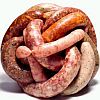Cure #2 is a curing salt containing sodium nitrite and sodium nitrate at set amounts - 6.25% Nitrite and 4% Nitrate. It is used for long term dry curing and can be bought here:
http://www.sausagemaking.org/acatalog/cure_2.html
It is used at a rate of 2.5gm per kg meat usually. HTH
Phil
Whole Pork Leg - What to Make?
35 posts
• Page 3 of 3 • 1, 2, 3
Re: Whole Pork Leg - What to Make?
AKASTUDY wrote:Hi ComradeQ,
Great blog. Many thanks for the informative pictures and data. I’m new to this game. Please could you tell me which no2 cure you used? Is there a reason for using sea salt as opposed to ordinary (pure) salt?
Also, what temperature did you equalise at?
Regards
Tony.
Uk.
Thanks Phil for answering about cure #2. I chose to use cure #2 for safety, however the Prosciutto di Parma makers in Italy collectively agreed to stop using nitrites and nitrates in 1993. There is some debate that the natural salts used in that region contain high naturally occuring nitrites/nitrates due to the high levels of mineral inpurities in the salts.
The sea salt choice I went with because it seemed appropriate to use Italian sea salts (they were not iodized - very important) I have spoken with friends who suggest a 50/50 combination of fine and coarse salt is the way to go as they break down and absorb at different rates. I just used fine sea salt myself.
I equalized in the press I made at anywhere between 1-3°C (whatever my fridge was running at). Once that was done I hung to start drying at 12°C and later applied the sugna. I think next time I would change two things: 1) I would use a heritage breed pig with a smaller ham and; 2) I would seriously debate boning it out completely either pressing as is after boning and while salting or try adding some transglutaminase into the cavity and then pressing to effectively glue the boned opening closed. I kind of like the idea of trying that although the purists would probably crucify me for it!
-

ComradeQ - Registered Member
- Posts: 332
- Joined: Mon Dec 31, 2012 3:27 am
- Location: Toronto, Canada
Re: Whole Pork Leg - What to Make?
Using the cure is a good call. If nothing else, it gives reassurance. I would bone the meat and for ease would cure the individual muscles, or make a culatello, which is a similar thing really.
Phil
Phil
-

wheels - Global Moderator
- Posts: 12894
- Joined: Sat Sep 02, 2006 4:29 pm
- Location: Leicestershire, UK
Re: Whole Pork Leg - What to Make?
I used cure #2 on my hams; I split the salt into three applications (each three weeks apart) and put all of the cure in the first salt treatment. I plan to cut the hams next fall so I can't tell how well this worked.
Fashionably late will be stylishly hungry.
- NCPaul
- Site Admin
- Posts: 2935
- Joined: Thu Oct 01, 2009 12:58 am
- Location: North Carolina
Re: Whole Pork Leg - What to Make?
Many many thanks for your very informative blogs. My first attempt used a tunnel boned leg (boned out by the butcher). The problem was, I ended up using nearly all the cure/salt on the first application, most of it was used trying to adequately rub cure/salt inside the tunnelled out area. Maybe I have used plain (pure) salt for subsequent applications?
I ended up binning the leg as I had miscalculated the amount if cure!!
I ended up binning the leg as I had miscalculated the amount if cure!!
- AKASTUDY
- Registered Member
- Posts: 7
- Joined: Sun Mar 04, 2018 12:45 pm
- Location: United Kingdom
35 posts
• Page 3 of 3 • 1, 2, 3
Who is online
Users browsing this forum: No registered users and 1 guest

